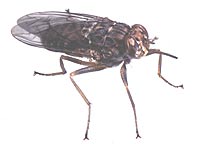Juliette McGregor
 This project run by
Juliette McGregor (Biological Sciences) has been funded by the Cabot Institute's annual Open Call 2012/2013. Below, Juliette explains how her project will look into how visual cues attract tsetse flys to insecticidal traps to help improve trap design and reduce crop damage and incidence of disease.
This project run by
Juliette McGregor (Biological Sciences) has been funded by the Cabot Institute's annual Open Call 2012/2013. Below, Juliette explains how her project will look into how visual cues attract tsetse flys to insecticidal traps to help improve trap design and reduce crop damage and incidence of disease.
Insects are of global importance as agricultural pests and carriers of human and animal diseases. Vector borne disease has been identified by the World Health Organization as a priority risk. The most deadly vector borne disease, Malaria, kills over 1.2 million people annually, mostly African children under the age of five. Similarly vector borne disease has a huge impact on animal health and economic productivity as the rapid movement of the midge borne Schmallenberg virus into UK farms this winter demonstrated. Furthermore climate change is increasingly causing the movement of agricultural pests into new habitats and this poses significant risk to our food security.
Harmful insects can be controlled by insecticidal traps, which often rely on olfactory cues to attract the target insects. However, exploiting insect colour preference to design more efficient traps has proved a successful, low environmental impact technique for one bloodsucking insect, the tsetse fly, which carries trypanosomiasis (sleeping sickness) in Africa. This prompts the question whether a more complete understanding of the visual systems of disease causing insects and pests would allow us to extend this approach to other species. By applying modern techniques and insight from a different discipline, Ecology of vision, to insect pest control, we have the opportunity to better understand key visual cues, improve trap design and ultimately reduce crop damage and the incidence of disease.
I am a physicist by training and have recently developed a new instrument, the ‘imaging microspectrophotometer (I-MSP), which increases the speed and facility of spectral data collection whilst also characterizing the spatial localization of visual pigments. This has been used to study the retinal pigments of fish and I now seek to adapt this instrument so it can be applied to the visual systems of problem insects.
Using tsetse flies as a model system, I will characterise the insect’s colour sensitivity to gain a basic understanding of visual transduction in this species and insight into the mechanisms underlying colour preference. Tsetse are ideal, because behavioural research has demonstrated that these flies prefer blue and this colour is widely used for traps and targets in Africa; moreover, the tsetse genome is currently being sequenced so the genes for visual pigments are known. This work would lay the foundation for the characterization of visual systems of other vectors and pests with a focus on informing control methods. By collaborating with the Laser Analytics Group in Cambridge the next generation I-MSP will be developed specifically to overcome the challenges of fully characterizing the colour sensitive rhabdomeres - the site of visual transduction in the compound eyes of insects.
